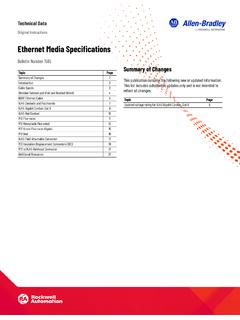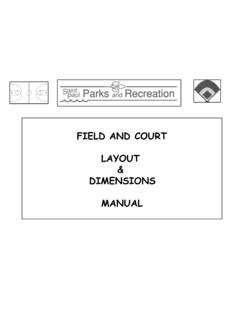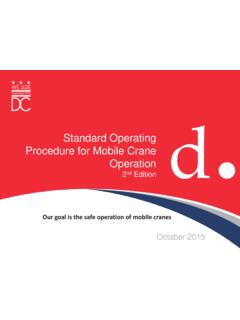Transcription of AIRSPACE, SPECIAL USE AIRSPACE, and TEMPORARY FLIGHT ...
1 AIRSPACE, SPECIAL USE AIRSPACE, and TEMPORARY . FLIGHT RESTRICTIONS. Course Notes Introduction: Today's pilots face many airspace challenges. The lack of knowledge of the airspace or improper preflight planning may result in a pilot deviation and violation of a FAR. It may even result in a serious incident or accident. The objective of this course is to help you understand: Classes of Controlled Airspace - communication and entrance requirements TEMPORARY FLIGHT restrictions (TFRs);. Other types of SPECIAL use airspace to include Prohibited Areas, Restricted Areas, National Security Areas and Air Defense Identification Zones.
2 Other Sources of information. Please note: There is a separate course found here on that covers the Washington SPECIAL FLIGHT Rules Area (SFRA). One of the most important concepts to take from this course is the need to understand the type of airspace you will be flying in and to check notices to airmen (NOTAMS) before every FLIGHT . even a short FLIGHT in your local airport practice area. To help prevent pilot deviations occurring from a lack of understanding of airspace issues this course was updated August 2010 to help pilots better understand airspace.
3 It was formerly called "TFRs and SPECIAL Use Airspace". If you have any questions about the content of this course please contact: Dennis Seals The course assumes a basic understanding of aircraft operation, air navigation, and air traffic control procedures. You can take the course at your own pace, exit at any time, and come back whenever it is convenient. Course notes are available for download. At the end of the course is a 20-question multiple choice quiz that you will need to take in a single session to complete the course. You may print a certificate of completion for your records upon successful completion of the course.
4 WINGS credit will automatically appear on your transcript upon successful completion of the end of course exam. Introduction Chapter 1 Classes of Airspace Chapter 2 TEMPORARY FLIGHT Restrictions Chapter 3 Types of TEMPORARY FLIGHT Restrictions Chapter 4 Prohibited Areas Chapter 5 Restricted Areas Chapter 6 Other SPECIAL Use Airspace Chapter 7 SFARs & Emergency Rules Chapter 8 Sources of Airspace Information Review Chapter 1: Controlled Airspace is a generic term that covers the different classifications of airspace (Class A, B, C, D and E airspace) and defined dimensions within air traffic control service is provided to IFR flights and to VFR flights in accordance with the airspace classification.
5 Definitions: Class A Airspace - Generally that airspace from 18,000 feet MSL up to and including FL 600, including the airspace overlying the waters within 12 nautical miles of the coast of the 48. contiguous States and Alaska; and designated international airspace beyond 12 nautical miles of the coast of the 48 contiguous States and Alaska within areas of domestic radio navigational signal or ATC radar coverage, and within which domestic procedures are applied. Unless otherwise authorized, all persons must operate their aircraft under IFR.
6 Class B Airspace - Generally, that airspace from the surface to 10,000 feet MSL surrounding the nation's busiest airports in terms of IFR operations or passenger enplanements. The configuration of each Class B airspace area is individually tailored and consists of a surface area and two or more layers (some Class B airspace areas resemble upside-down wedding cakes), and is designed to contain all published instrument procedures once an aircraft enters the airspace. An ATC clearance is required for all aircraft to operate in Class B Airspace, and all aircraft that so cleared receive separation services within the airspace.
7 The cloud clearance requirement for VFR operations is "clear of clouds". Arriving or transiting aircraft must obtain an ATC clearance prior to entering Class B airspace on the appropriate frequency and relation to geographical fixes shown on local Class B charts. Departing aircraft require a clearance to depart Class B airspace and should advise clearance delivery of their intended altitude and route of FLIGHT . Unless otherwise authorized by ATC, aircraft must be equipped with an operable two-way radio capable of communicating with ATC on appropriate frequencies for that Class B airspace.
8 Also unless otherwise authorized by ATC the aircraft must be equipped with an operable radar beacon transponder with automatic altitude reporting equipment. There are currently 12 airports with Class B airspace where the pilot in command must hold at least a private pilot certificate to take off and land. At other Class B airports a student pilot or recreational pilot who seeks private pilot certification may take off and land if certain requirements are met. The student or recreational pilot must receive ground and FLIGHT instruction from an authorized instructor and receive an endorsement from that instructor stating the student or recreational pilot is proficient to conduct solo operations at the specific Class B Airport & Airspace.
9 Mode C Veil A mode C transponder with altitude reporting is required within 30 nautical miles of a Class B airport from the surface to 10,000 feet MSL. An aircraft that was not originally certificated with engine driven electrical system or which has not subsequently been certified with a system installed may conduct operations within a Mode C veil provide the aircraft remains outside Class A, B, or C airspace; and below the altitude of the ceiling of a Class B or Class C airspace area designated for an airport or 10,000 feet MSL, whichever is lower.
10 Class C Airspace Class C Airspace is generally that airspace from the surface to 4,000 feet above the airport elevation (charted in MSL) surrounding those airports that have an operational control tower, are serviced by a radar approach control, and have a certain number of IFR operations or passenger enplanements. Although the configuration of each Class C airspace area is individually tailored, the airspace usually consists of a 5 NM radius core surface area that extends from the surface up to 4,000. feet above the airport elevation, and a 10 NM radius shelf area that extends no lower than 1,200.
















